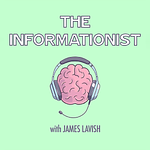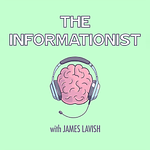In this episode, we roll up our sleeves and dig into the realm of Treasury Inflation-Protected Securities or, as they are more commonly known, Tips, and their close relatives, I-Bonds. Like usual, we take these puzzling topics and break them down into bite-sized, easy-to-understand pieces. We explain what these securities are, the nitty-gritty of how they're priced, and explore whether they deserve a spot in your investment toolbox.
Today’s Bullets:
What are TIPS?
What are I-Bonds?
How are they priced?
Are they a good investment?
Join the 🧠Informationist community and get access to every post + the entire archive of articles.
You’ll soon understand the most important financial topics around you, easily and quickly. That’s my guarantee.
The Calculations:
Let’s say, you have a TIPS with a principal of $1,000:
If the semiannual inflation rate is 1%, the adjusted principal would be $1,000 * (1 + 0.01) = $1,010
And if the semiannual inflation rate is -1%, the adjusted principal would be $1,000 * (1 - 0.01) = $990
The above adjusted principal is then used to calculate the amount of interest payments. Let’s say you’re $1,000 TIPS has a 3% interest rate, and so in the above example:
$1,010 * .03 = $30.30
and
$990 * .03 = $29.70
The higher the inflation, the more interest you are paid, and vice versa.
For I-Bonds, the calculation is:
Composite rate = [Fixed rate + (2 x Semiannual inflation rate) + (Fixed rate x Semiannual inflation rate)]
Come again?
OK let's say you have an I-Bond with a fixed rate of 0.5% (or 0.005), and the most recent semiannual CPI-U inflation rate was 2.5% (or 0.025).
Substitute these values into the formula:
Composite rate = [0.005 + (2 x 0.025) + (0.005 x 0.025)] = [0.005 + 0.05 + 0.000125] = 0.055125
Therefore, the composite rate for this I-Bond would be approximately 5.51% for the next six months.
Links:
FULL TRANSCRIPT:
Welcome to The Informationist, the podcast that breaks down complex financial concepts into simple, fast, and easy-to-understand terms. We realize that financial jargon can be overwhelming, so we make it our mission to bring you accessible information, helping you to use financial terms and concepts to your advantage. Stay updated by subscribing to The Informationist podcast today!
In today's episode, we're rolling up our sleeves and digging into the realm of Treasury Inflation-Protected Securities or, as they are more commonly known, TIPS, and their close relatives, I-Bonds. Like usual, we'll take these puzzling topics and break them down into bite-sized, easy-to-understand pieces. We'll explain what these securities are, the nitty-gritty of how they're priced, and explore whether they deserve a spot in your investment toolbox. So, whether you're a savvy saver, an investment newbie, or just someone curious about the financial world, join us as we make sense of these fascinating topics in a way that everyone can understand.
Here’s your host, James Lavish.
Ah yes, inflation. Something we haven’t hear quite enough about recently, have we?
It’s not that we’re sick of hearing about inflation. It’s that we’re sick of EXPERIENCING the EFFECTS of inflation.
I mean, who here hasn’t noticed that a Costco ribeye now costs about what a Whole Foods Wagyu filet used to?
In any case, whether we can believe the above chart or not, that’s not really the point here. What we need is a way to battle inflation. To fight back.
To save our hard earned money and protect it from that silent super tax.
And so, it’s no surprise that a lot of people have been asking me recently if buying Tips or I-Bonds is a good way to do just that.
But first, let’s clarify what these securities are, how they’re priced, and what makes them different from each other. And most importantly, are they, in fact, a good investment?
Lots to cover here today, but no worries, we’ll cut through it like a Navy Seal Kay-bar through that hundred and forty dollar Wagyu filet.
So, grab yourself a cup of coffee and settle in for another episode of The Informationist!
To start, let’s clear up exactly what Tips securities are and what their stated purpose is. Whether or not they succeed, well, that’s a different story entirely, as we’ll see.
But in essence, Treasury Inflation-Protected Securities (also known as TIPS) are exactly what they sound like: bonds offered by the US government that (supposedly) protect investors from inflation.
How?
First, let’s remember how bonds work. When you buy a bond, you have the face value and the interest rate. And so, if the price of the bond goes down, that means the interest you earn on that bond rises, and vice versa.
Back to TIPS.
First issued in 1997, TIPS are bonds sold by (surprise surprise) the US Treasury. They’re available in maturities of 5, 10, and 30 years, they pay interest (on face value) semi-annually, and the value of the bond principal is adjusted semi-annually based on changes in the Consumer Price Index (as many of you know as CPI).
But remember that last little oh-so-important detail. We’ll come back to it in a minute.
In any case, upon maturity, investors are paid an adjusted principle or original principal, whichever is greater.
Sounds pretty good, right? So, what’s the catch?
Well, let’s check out I-Bonds next, and then we’ll carve a little deeper into these fatty deals.
I-Bonds, much like TIPS, are also meant to protect investors from inflation. They’re also offered by the US Treasury, but interest that accrues in I-Bonds is not subject to federal income tax until the bond is cashed in, and they are exempt from state and local income taxes.
Two small catches, though: I-Bonds only come in 30-year maturities and total purchases are limited to ten thousand dollars.
Wait. Are you suggesting I loan the government my money for 30-years? Ha.
No problem, I’ll just sell in the secondary market if I don’t want to hold them any more.
Except I-Bonds don’t trade in the secondary market. The US Treasury itself is the one and only buyer and seller that you can deal with.
So, you’re locked up for one year minimum. If you want to sell them after that and it is less than five years, you’ll forfeit your last three months of interest to the dealer, the Treasury.
Which gets us to how these are priced and earn interest for you.
The earnings rate for I-Bonds is a combination of a fixed rate, which stays the same for the life of the bond, and the inflation rate, which is adjusted twice a year (in May and November) based on changes in the CPI.
There’s that pesky CPI again.
Just how important is it? First let’s look at how each of these bonds are priced and that may help us better understand.
One key to all this seems to be exactly how these so-called inflation protection bonds are priced in order to ‘protect’ you.
Lets cover TIPS pricing first.
The principal of a TIPS is adjusted based on changes in the CPI-U. The CPI-U measures the average change in prices over time that urban consumers (supposedly) pay for a basket of goods and services.
See, the US Treasury adjusts the principal of TIPS semiannually—twice a year—to account for inflation or deflation. This is done by multiplying the principal by one plus the semiannual inflation rate.
And so, if there is inflation, the principal is increased, and if there is deflation, the principal is decreased.
For instance.
Let’s say, you have a TIPS with a principal of $1,000:
If the semiannual inflation rate is 1%, the adjusted principal would be $1,000 times (1 + 0.01) which equals $1,010.
And if the semiannual inflation rate is -1%, the adjusted principal would be $1,000 times (1 - 0.01) which equals $990.
The above adjusted principal is then used to calculate the amount of interest payments. Let’s say you’re $1,000 TIPS has a 3% interest rate, and so in the above example:
$1,010 times .03 equals $30.30
and
$990 times .03 equals $29.70
The higher the inflation, the more interest you are paid, and vice versa. Got it?
One more thing.
The initial price paid for a TIPS is determined in the US Treasury auction. If you’re interested in how this works, I covered UST auctions in a recent Informationist article. I leave a link in the show notes.
TL;DR: the stronger the auction, the higher the bond price and lower the yield, and vice versa.
And because these are often bought and sold in the secondary market, you have to also take into account and calculate the actual yield you are getting according to the price you pay for the TIPS in the market.
I.e., it’s more complicated to trade these than I-Bonds.
OK, so now let’s look at I-Bonds Pricing.
I-Bonds are sold at face value by the Treasury, not in a Treasury auction. So, if you buy a $50 I-Bond, you will pay $50, and it will be worth $50 upon redemption.
Simple.
Then, the total return on I-Bonds is based on a combination of a fixed rate and the inflation rate. The fixed rate remains the same for the life of the bond, while the inflation rate is adjusted semiannually based on changes in…?
You guessed it. The CPI-U rate.
The calculation is:
Composite rate equals the Fixed rate plus 2 times the Semiannual inflation rate plus the Fixed rate times the Semiannual inflation rate
So you can visualize that, here’s an example.
OK. Let's say you have an I-Bond with a fixed rate of 0.5% (or 0.005), and the most recent semiannual CPI-U inflation rate was 2.5% (or 0.025).
Substitute these values into the above formula, and it basically compounds the current rate with the calculated CPI readings to give us a composite rate for this I-Bond of 5.51%.
In other words, returns on these bonds are highly dependent on one thing and one thing only: the CPI number.
So, that begs the real question at hand.
Are they a good investment?
To answer, we must then consider CPI.
One of our favorite government manipulation—er, calculations coming out of the Bureau of Labor Services or BLS.
Which we sometimes just shorten to BS around here.
Why?
Because, let’s face it. The CPI is a hopelessly flawed and problematic calculation that sometimes seems to have absolutely nothing to do with the real life, actual prices that people are paying for goods and services they need.
I’ve gone into this in depth a number of times, and if interested, you can read much more about CPI in the pair of articles referenced in the show notes.
But, suffice to say, the actual inflation numbers are far higher than the Fed, the Bureau of Labor Services, and White House ever admit to.
Period.
I go into the flaws and reasons in great detail in the above articles, and I encourage you to check them out.
In any case, the point is that neither TIPS nor I-Bonds offer positive real rates in the real world.
Remember:
Interest on a bond minus the ACTUAL inflation rate equals your REAL rate of return.
And in order to TRULY be protected from inflation, you need a POSITIVE real rate of return on your investment.
That’s number one.
Secondly, why lock yourself into a flawed inflation-priced bond that you may have to pay a penalty on when redeeming within 5 years? When they manipulate inflation down to the 2 to 3% range (and it’s REALLY more like 7 to 9%, or more…), your bond’s real yield will be lower and lower every month.
In fact, seeing how we’re currently on a virtually 100% likelihood trajectory of a recession, I-Bonds seem a less-than-ideal investment at this time. Especially if we hit a hard recession (also likely, in my opinion), which would ultimately push the Fed and Treasury to step in and inject liquidity into the markets.
You got it. Enter the money printer.
The money supply expands and we have inflation all over again.
But likely higher this time.
And if you’re truly worried about coming inflation due to a hard recession and then an equally hard Fed pivot to the money printer, then why wouldn’t you hold some HARD assets instead?
Like gold. Like silver.
Like Bitcoin.
Because if and when the Fed does pivot, those hard assets will likely soar far ahead of any CPI-U inflation adjustment for these so-called Tips and I-Bonds.
Remember, the US Treasury’s mission is the PRETEND inflation is lower than it is, hide the fact that it is actually high, and OBSCURE the reality that the USD is programmed to debase.
Still, I believe studies like this are an important exercise for all of us.
After all, we need to stay on our toes out here and not be fooled into 4-times over-priced ribeyes, when there may be a Wagyu filet…sitting right there for the taking.
The information in this newsletter is not intended to constitute individual investment advice and is not designed to meet your personal financial situation. It is provided for information purposes only and nothing herein constitutes investment, legal, accounting or tax advice, or a recommendation to buy, sell or hold a security. We strongly advise you discuss your investment options with your financial adviser prior to making any investments, including whether any investment is suitable for your specific needs.














Pod: Are TIPS a Good Investment?